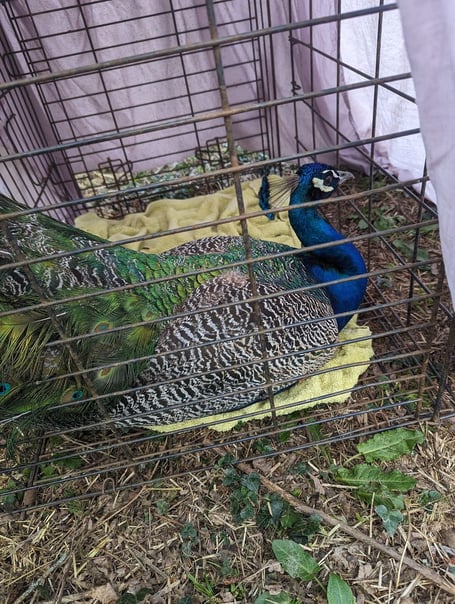Cats often go missing but something a bit more unusual is a missing peacock.
Houdini, named after the legendary escapologist, has just been found and returned to his owner in Yealmpton, Abby Davies.
Through the Yealmpton Facebook Group Abby posted:
“I just want to say a MASSIVE thank you to the people of Yealmpton for all their support and help in finding the missing peacock.
“With your combined effort he’s now back where he belongs! (although for how long?)
“Since Friday, I’ve traped through many a garden, crumpled some flower beds, thrown apples and bananas about and even knocked on doors at 8am on Sunday morning.
“I’ve met many new faces and to everyone that helped at one point or another, I wanted to thank you all personally but there are too many of you. I’m also really sorry for all the hassle caused.
“All there’s left to say is what an incredibly community minded, kind, reliable and supportive village you make up.
“Not one person made us feel like we were inconveniencing them and we couldn’t have got him home without you.
“Lastly, to the Animal Expert that is Matthew Pearce Matthew Pearce goes my external gratitude for being super knowledgeable and ever willing to assist and who expertly made the capture.
“We’ll see if we can keep Houdini locked up this time.
Male peafowl are referred to as peacocks, and female peafowl are referred to as peahens, although peafowl of either sex are often referred to colloquially as “peacocks.”
The two Asiatic species are the blue or Indian Peafowl originally of the Indian subcontinent, and the green peafowl of Southeast Asia; the one African species is the Congo peafowl, native only to the Congo Basin.
Male peafowl are known for their piercing calls and their extravagant plumage. The latter is especially prominent in the Asiatic species, which have an eye-spotted “tail” or “train” of covert feathers, which they display as part of a courtship ritual.
The functions of the elaborate iridescent colouration and large “train” of peacocks have been the subject of extensive scientific debate.
Charles Darwin suggested that they served to attract females, and the showy features of the males had evolved by sexual selection.
More recently, Amotz Zahavi proposed in his handicap theory that these features acted as honest signals of the males’ fitness, since less-fit males would be disadvantaged by the difficulty of surviving with such large and conspicuous structures.





Comments
This article has no comments yet. Be the first to leave a comment.